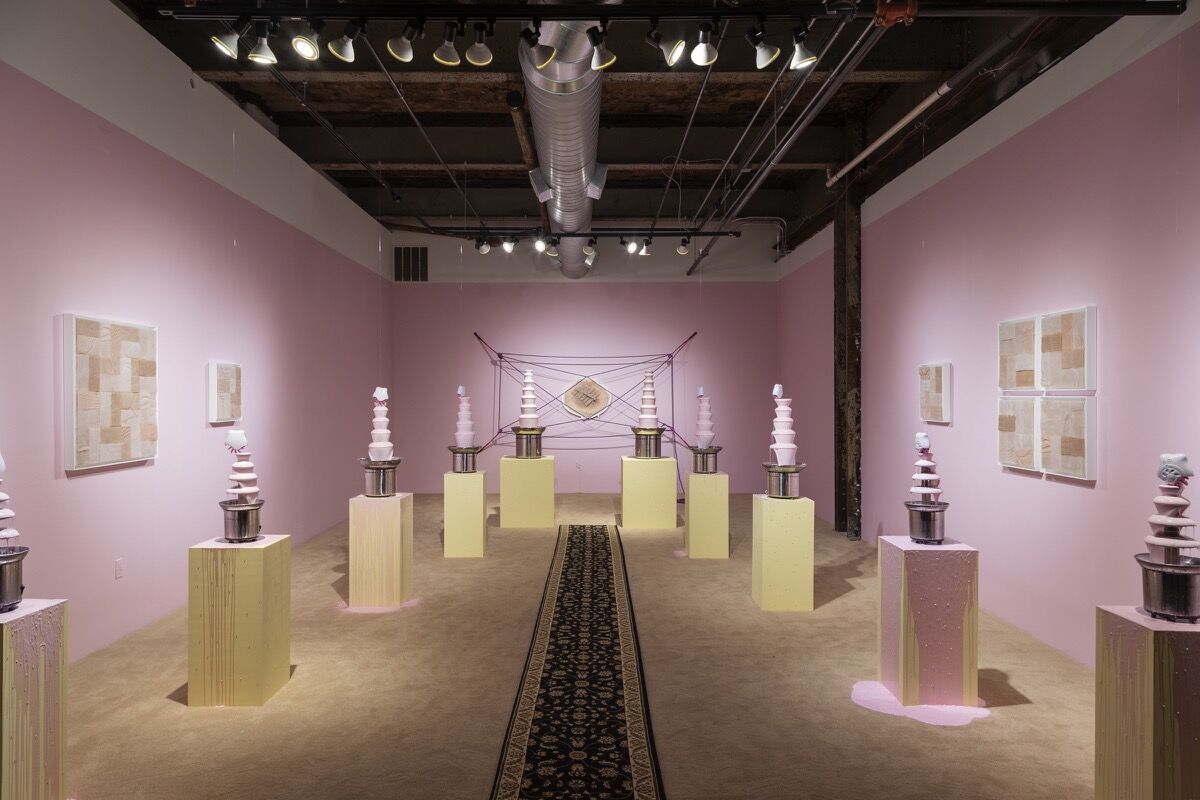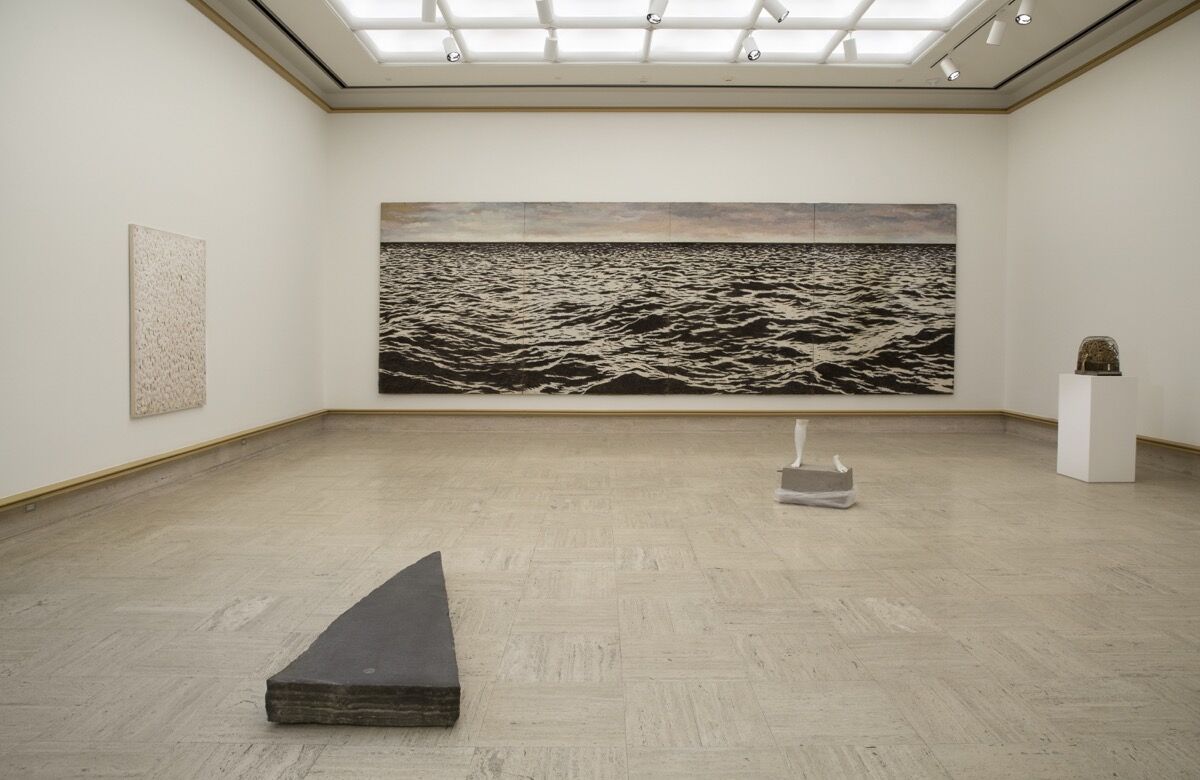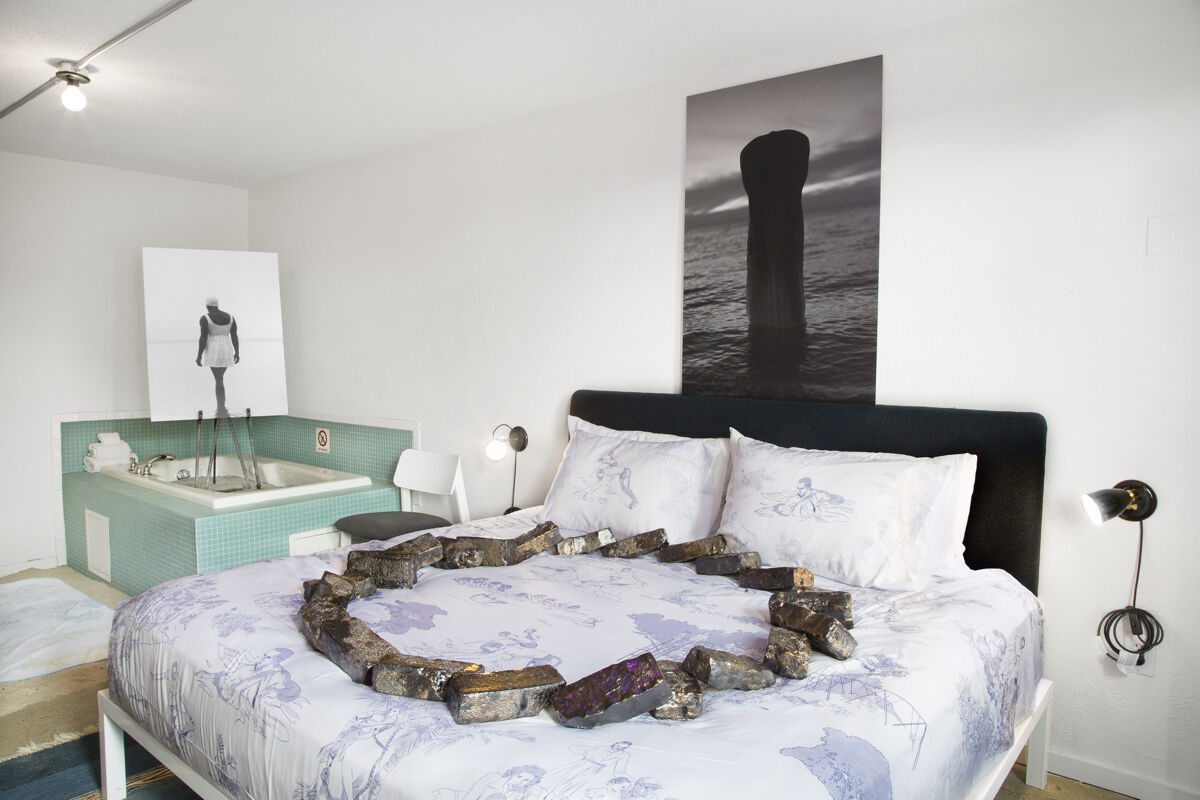Written by Claire Voon, Aug 13, 2019 6:21pm

Work by Pamela Council, in “Resident Artist Exhibition,” at Red Bull Arts Detroit, 2019. Photo by Claire Gatto.
Detroit’s Black Bottom neighborhood was razed in the 1950s to accommodate a freeway and a Mies van der Rohe–designed residential development. Before then, it was the heart of the city’s Black community. The destruction displaced hundreds—but from its architectural remnants, Charles McGee made art. The Detroit-based artist, now 94, salvaged wood and plaster to create assemblages that still evoke a deep sense of loss four decades later.
One work, Urban Extract I (1979), is displayed in “Landlord Colors: On Art, Economy, and Materiality,” an exhibition at the Cranbrook Art Museum that explores global periods of economic and social collapse. Nearby are pieces by fellow Detroit artists, including Allie McGhee, Olayami Dabls, and Carole Harris, who also found inspiration in their damaged streets following the 1967 Detroit Riots. Seen together, their transformations of discarded material assert a plain truth: that Detroit has always been a city of resourceful artists, where creativity thrives despite crises.
This history feels evermore vital to uphold, as Detroit’s art scene increasingly receives national attention—and spotlight from outsider writers like myself. The city has been fetishized, with its promise of affordability, as a gritty, old New York or a cheap alternative for Brooklyn’s creative class. Such narratives tend to erase Detroit artists—Black artists, especially—who are working to build the foundations of an art community in a city that is simultaneously gentrifying and emerging from bankruptcy.“Now that developers are looking at these buildings, the media is putting a specific spin on Detroit,” artist Tylonn J. Sawyer told me. “People use the words ‘blank canvas,’ and they come and displace others.”
In reality, the creative landscape is more complicated. Detroit’s art infrastructure has grown in the last decade, as galleries and organizations like Red Bull Arts and Playground Detroit have settled in. There’s financial support from groups like the Knight Foundation and the Kresge Foundation, the latter of which annually awards $25,000 grants to local artists. But not everyone has access to these shiny opportunities.

The city is an arts haven in the sense of liberation that it offers to many artists. Sawyer likens Detroit to Black Panther’s Wakanda; a utopia for Black artists to experiment freely. “Our creativity doesn’t necessarily come from the art world’s status quo,” he said. “Unlike New York, where you can see things that are derivative, Detroit is special.”
Aleiya Lindsey was struck by the raw entrepreneurship driving her city’s art scene when she moved there back in 2011 from Chicago. She noticed studios and experimental spaces in every neighborhood, and the uptick in white-walled galleries. Last year, after joining Olu & Company, a marketing agency founded by Amani Olu, she and Olu launched an annual program to bring together and celebrate this community: Detroit Art Week (DAW), a schedule of city-wide exhibitions, performances, open studios, and panels.
It is, perhaps, the best way to absorb the singular dynamism of Detroit’s contemporary art scene, particularly on a time crunch. Nineteen galleries—about 70 percent of local spaces, Lindsey estimated—adjusted their schedules to align with the second iteration this past July. They included veteran spaces like N’Namdi Center for Contemporary Art, which has represented African American artists since the 1980s; and Simone DeSousa Gallery, whose past shows have honored Detroit’s historic Cass Corridor Movement. Younger galleries, from the artist-run What Pipeline to commercial spaces like Reyes | Finn and David Klein Gallery, also participated.
“Everyone’s always done their own thing,” Lindsey said. “DAW connects and ignites our community so we can have an overview of where we are. It’s possible that this could have happened 10 years ago, but it wouldn’t have looked like this.”While I was in Detroit, it did feel like the city’s creatives had scheduled their week around DAW, from an opening–cum–taco party at Reyes | Finn to a curatorial takeover of rooms at the hotel Trumbull and Porter. At an opening at garage–turned–ceramics studio Hamtramck Ceramck, I met sculptor Matthew Angelo Harrison, whose complex replicas of African objects are currently in exhibitions from “Landlord Colors” to the Whitney Biennial.
Harrison grew up in Grosse Pointe, a Detroit suburb, and returned in 2012 after studying in Chicago. “I thought I was going to move to one of the coasts, but I ended up staying,” he said. “I realized what I could accomplish here with the isolation from coastal influences, while still having access to cities like New York and Philadelphia.” Having a huge studio also helps—but he added that most artists struggle to find affordable spaces in Detroit.

“There’s money, but not for everybody,” Angelo Harrison said. “Control is in the hands of people who have capital, not those who supply the culture. There needs to be a real way for artists to build communities that are long-lasting and have influence.”
Vacant buildings dot much of Detroit, but that doesn’t equate to cheap and well-ventilated workspaces. “You think finding a studio is easy, but not everybody can buy a building and put in studios,” sculptor Scott Vincent Campbell offered.
Campbell, a native New Yorker, moved to Detroit in 2015, and eventually found a workspace at the building 333 Midland. A New Zealander had bought the former factory in Highland Park—a city surrounded by Detroit—in 2013, and transformed it into an art center. Campbell pays $337 monthly for his 500-square-foot space, but noted that rents are already rising. “Artist studios get filled up pretty quickly,” he said. “And people are getting priced out.”
Tiff Massey is more than familiar with this scenario. The artist creates sculptures that explore the complexities of Black womanhood, African diasporic culture, and her experience as a native Detroiter. Standing in her studio, surrounded by metalworks and collages of gingham and Kente cloth, she recalled having been priced out of and exposed to carbon monoxide in previous ateliers. “The spaces developers are carving out for artists are small—like cubicles,” she said. “They don’t understand what an art practice takes.”
Massey is a lifelong Detroiter. For someone who sculpts with metal, the automotive industry offers unparalleled resources. Plus, demanding cities like New York City and Los Angeles never appealed to her. In 2011, when she graduated from the Cranbrook Academy of Art, she was practically the only one in her class who stayed in Detroit. “Six to ten years ago, nobody wanted to be from Detroit,” she said. “But more and more, people are seeing if they can make a stamp.”
“I’m down with the increased spotlight,” Massey continued. “There’s room for collaboration and growth, but we hope that you have respect. Don’t try to Columbus it.”
One transplant that has had growing pains is Red Bull Arts Detroit, a hub of residencies and exhibition spaces. The Detroit outpost launched in 2011 as Red Bull House of Art, and has received criticism from local artists who felt like they didn’t have enough access to its opportunities. But last year, Red Bull revised its programming to dedicate more resources to the Detroit community. One notable initiative awards $1,000 no-strings-attached microgrants to Detroit-based artists throughout the year. “We want to entice people to stay and build a career in Detroit,” program manager Matt Eaton said.

Microgrant recipient Bree Gant said she appreciates how programs like Red Bull and DAW are connecting her city to a broader arts conversation. She returned in 2012 after college, and recalled how “there wasn’t a lot of arts infrastructure here, but there was space to write your own narrative.” Gant found support in nonprofits like the arts advocacy group Creative Many Michigan, but many of these have shuttered.
One profound loss was Baltimore Gallery, which championed emerging Black artists and curators. Founded in 2013 by Flaco Shalom, it’s where curator and current Kresge artist fellow Darryl DeAngelo Terrell organized their first exhibition. The Detroiter, who received their MFA in Chicago, moved home in March because of the lower cost of living, and now builds networks between the two cities. “Baltimore Gallery was a Black safe space,” Terrell said. “But people moving into the area were complaining about not feeling safe.” The gallery closed in June, as director Phillip Simpson wanted to focus on personal endeavors.
Its departure underscores the need for spaces that serve the Detroit community. One newcomer hoping to make its mark is the two-year-old Reyes | Finn, which showcases some out-of-towners but largely strives to work with artists “who have a strong connection to Detroit, whether that’s being born here or living here,” managing director Bridget Finn said. The gallery also aims to strengthen Detroit’s ties to outside markets by participating in art fairs. “It’s really important for us to work with people in Detroit and bring the work outside,” Finn added.
Artists I met said they want more national recognition of their community, whether from galleries, collectors, or publications. But they emphasized that they can have longevity, only if more investment happens on a local level. Terrell desires more Detroit-focused grants to decrease competition between artists. Gant wishes for more arts administration, particularly an arts council. “We say we’re an arts city, but we only just got a director of culture,” she said.
Massey laments the lack of schools with arts curricula. But she’s taking action: In 2017, she purchased a 10,000-square-foot building on Detroit’s west side, to eventually transform into a nonprofit artist incubator. She envisions it as a school with 10 departments, as well as studios and residencies.
When we spoke again, over the phone, Massey rattled off some questions driving her: “On the local level, how do we make culture important again? How do you talk about artists having longevity? Who are the future artists?”“I’d like to give my colleagues space where they can work and not worry about moving,” she continued. “Then they can give back.”
The post Artsy // As Detroit’s Art Scene Grows, Local Artists Face New Challenges appeared first on PLAYGROUND DETROIT.
